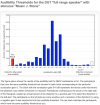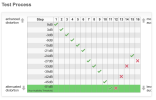Vineethkumar01
Well-Known Member
Hi all,
I found this distortion test on ASR recently. I found it very interesting:
It basically helps us understand at what level of THD each of us, through our audio systems, are able to audibly make out total harmonic distortion.
My personal score as per this video (on my cheap 600Rs edifier earphones) is as follows:
Music: around 11% THD
Tone at 500 Hz: around 5%
Tone at 100 Hz: around 11%
Please test and post your results..
I found this distortion test on ASR recently. I found it very interesting:
It basically helps us understand at what level of THD each of us, through our audio systems, are able to audibly make out total harmonic distortion.
My personal score as per this video (on my cheap 600Rs edifier earphones) is as follows:
Music: around 11% THD
Tone at 500 Hz: around 5%
Tone at 100 Hz: around 11%
Please test and post your results..



